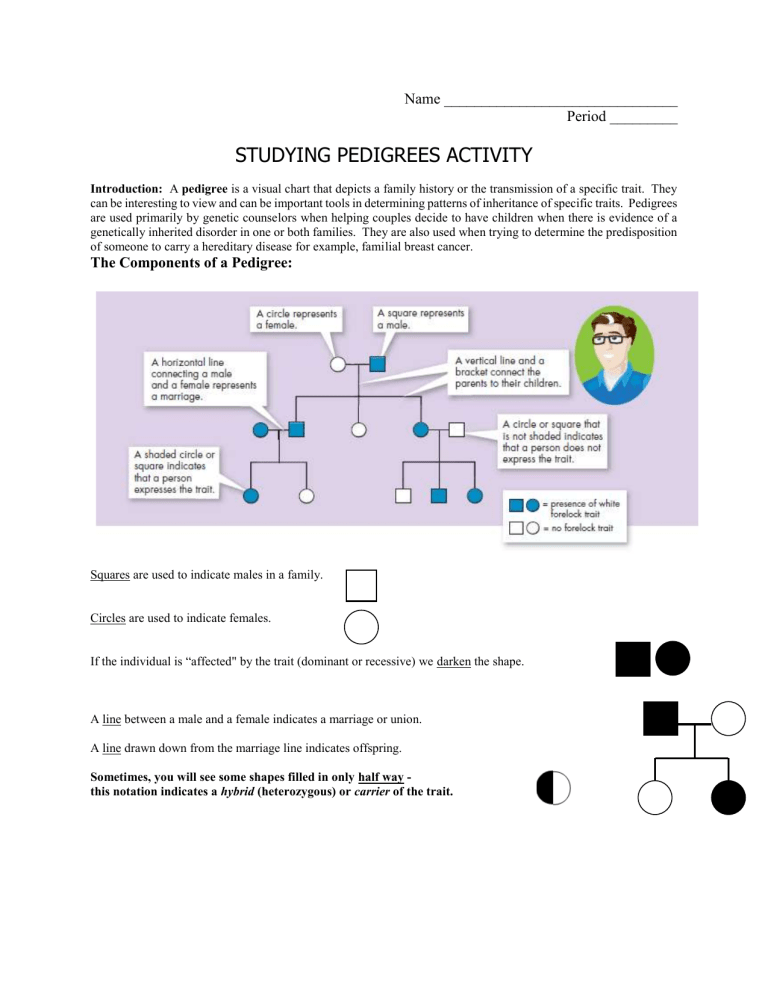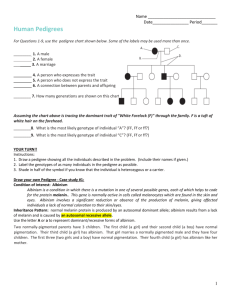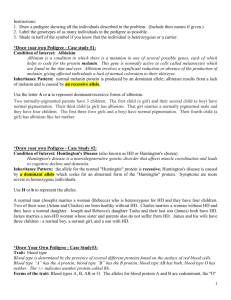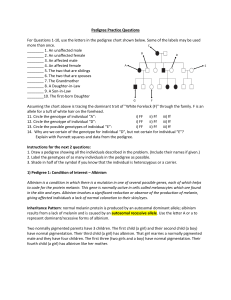Pedigree Analysis Activity: Genetics & Inheritance

Name _______________________________
Period _________
STUDYING PEDIGREES ACTIVITY
Introduction: A pedigree is a visual chart that depicts a family history or the transmission of a specific trait. They can be interesting to view and can be important tools in determining patterns of inheritance of specific traits. Pedigrees are used primarily by genetic counselors when helping couples decide to have children when there is evidence of a genetically inherited disorder in one or both families. They are also used when trying to determine the predisposition of someone to carry a hereditary disease for example, familial breast cancer.
The Components of a Pedigree:
Squares are used to indicate males in a family.
Circles are used to indicate females.
If the individual is “affected" by the trait (dominant or recessive) we darken the shape.
A line between a male and a female indicates a marriage or union.
A line drawn down from the marriage line indicates offspring.
Sometimes, you will see some shapes filled in only half way - this notation indicates a hybrid (heterozygous) or carrier of the trait.
Instructions:
1. Draw a pedigree showing all the individuals described in the problem. (Include their names if given.)
2. Label the genotypes of as many individuals in the pedigree as possible.
3. Shade in half of the symbol if you know that the individual is heterozygous or a carrier.
*Draw your own Pedigree - Case study #1:
Condition of Interest: Albinism
Albinism is a condition in which there is a mutation in one of several possible genes, each of which helps to code for the protein melanin.. This gene is normally active in cells called melanocytes which are found in the skin and eyes. Albinism involves a significant reduction or absence of the production of melanin, giving affected individuals a lack of normal coloration to their skin/eyes.
Inheritance Pattern: normal melanin protein is produced by an autosomal dominant allele; albinism results from a lack of melanin and is caused by an autosomal recessive allele.
Use the letter A or a to represent dominant/recessive forms of albinism.
Two normally-pigmented parents have 3 children. The first child (a girl) and their second child (a boy) have normal pigmentation. Their third child (a girl) has albinism. That girl marries a normally pigmented male and they have four children. The first three (two girls and a boy) have normal pigmentation. Their fourth child (a girl) has albinism like her mother.
*Draw Your Own Pedigree - Case Study#2:
Trait: blood type
Blood type is determined by the presence of several different proteins found on the surface of red blood cells. Blood type “A” has the A protein; blood type “B” has the B protein; blood type AB has both; blood type O has neither. The +/- indicates another protein called Rh.
Forms of the trait: inheritance via autosomal multiple allelism (A, B, or O) results in the blood types A, B, AB or O. The alleles for blood protein A and B are codominant, the "O" allele is recessive to both the A and B alleles.
Use AA, AO, AB, BB, BO or OO to represent the genotypes.
As a 9 th
-grade school project, Maureen decides to trace the inheritance of blood types through her extended family, all the way back to her great-grandmother Katherine. Here’s what Maureen found out….
Maureen’s great-grandmother Katherine, has A type blood. Katherine and her husband John had four children – two sons, Michael (who has blood type AB) and David (who has type O blood); a
daughter (Jessica) with type O blood and another daughter (Jennifer) with type A blood. Jessica never married; her sister Jennifer did get married and had three sons (one with type A blood, one with type AB blood and one with type O blood). Both of Katherine's sons also get married –
Michael marries a woman with type O blood and together they have two daughters (Anna – type
A; Leanne – type B); David marries a woman with type A blood, and they have three children
(daughter Fran and son Albert who both have type A blood, and a son Matthew with type O blood).
Matthew marries Janine and together they have one daughter, Maureen . Maureen knows that her parents both have the same blood type, but she has never yet had a blood test to determine her own blood type.
*EXTENSION: Draw Your Own Pedigree – Case Study #3
Condition of Interest: Hemophilia
Hemophilia is a blood clotting disorder in which one of the proteins needed to form blood clots is missing or reduced (commonly, the protein known as Factor VIII).
Individuals have difficulty forming blood clots following injury and may suffer significant blood loss from even minor cuts and bruises.
Inheritance Pattern: Factor VIII is an essential blood clotting protein which is formed by a normal allele found on the X chromosome; hemophilia is caused by a lack of Factor VIII which results from a recessive allele found on the X chromosome.
Remember that because this is an X-linked disorder, when you identify genotypes in this pedigree, you must use the XX/XY notation and use superscripts with each X chromosome to indicate whether the “H” (normal) or “h” (hemophilia) allele is present. (Ex. X H Y = normal male)
Hemophilia became known as the “Royal disease” after it suddenly cropped up in some of the descendents of Great Britain’s Queen Victoria and spread through the royal families of Europe.
Queen Victoria and her husband Prince Albert had 9 children – 5 girls (Beatrice, Victoria, Alice,
Helena, and Louise – none of whom were hemophiliacs) and 4 boys (Edward, Alfred and Arthur had normal blood clotting; their son Leopold, however was a hemophiliac). Beatrice married a man named Henry and they had four children (sons Leopold and Maurice who were hemophiliacs, daughter Eugenie who was not a hemophiliac, and another son who was also not a hemophiliac).
Eugenie married Alfonso XIII of Spain (non-hemophiliac) and they had 6 children (2 normal sons,
2 normal daughters and 2 hemophiliac sons). One of those normal sons married a non-hemophiliac woman and gave birth to one son – a non-hemophiliac they named Juan Carlos (the reigning King of Spain).
Draw your pedigree for Case Study #2 and #3 on the back of this page.











